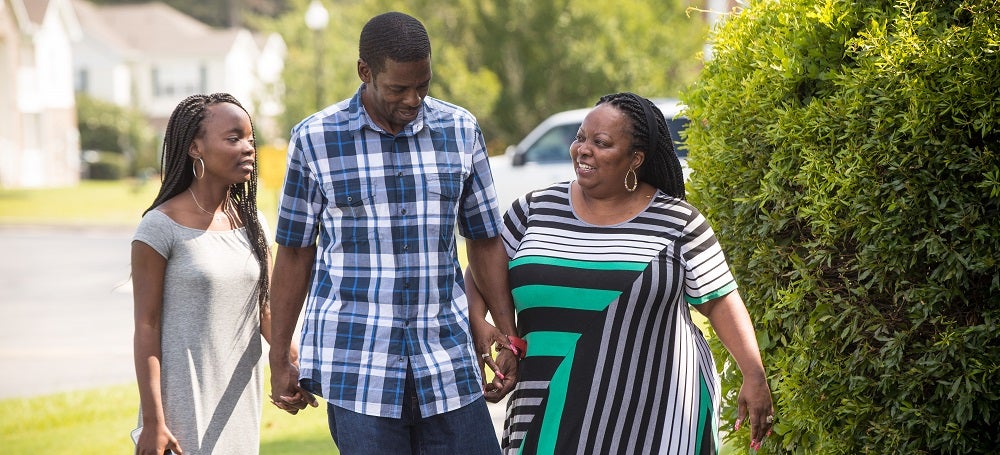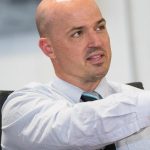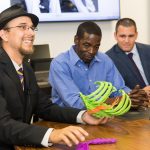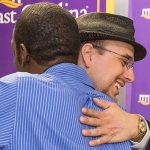College Collaboration Means Quality of Life to Patient
If you were to ask Dr. Ranjeet Agarwala, assistant professor with ECU’s College of Engineering and Technology, the dream of having his college collaborate with ECU’s Brody School of Medicine, and the Joyner Library started when his daughter was 2 years old. At that time in 2014, his daughter needed a thoracic procedure. During that process, Agarwala began to see the role 3D printing could play in the health field.
“I knew ECU had the infrastructure to use this innovation to have an amazing impact in the future,” said Agarwala, who has expertise in computer-aided design.
In March 2017, Agarwala’s opportunity to merge innovation and patient care presented itself.
Dr. Carlos Anciano, thoracic surgeon and ECU assistant professor, and Dr. Preston Sparks, ECU cardiothoracic surgery fellow, met Franklin Arnold of Goldsboro.
Born with a twisted spine, Arnold had prior corrective surgeries, which caused a deformity in his chest. Ribs were removed. Calcium deposits grew. This caused what Arnold described as traumatic pain that impaired his daily functions, forced him to wear a brace for two years, and started to take away his breath.
“I kept telling everybody I’m having major pain here,” said Arnold. “I was on a lot of pain medicine.”
Arnold was referred to Anciano and Sparks from his pain management physician Dr. Juan Firnhaber of Greenville.
Collaboration using 3D printing
After meeting with Arnold, Anciano and Sparks discussed treatment options. Sparks, who is on active military duty and completing his surgery fellowship at ECU and Vidant Medical Center, said he was not used to seeing this kind of chest wall trauma in Greenville. It resembled traumatic injuries accustomed to battlefields and wartime.
“I was in Dr. Anciano’s clinic when we saw Franklin come in initially,” said Sparks. “We (Sparks and Anciano) sat down between cases one day, and he said he had this idea.”
That idea was to introduce 3D technology into Arnold’s treatment plan.
Hoping to make this idea happen and knowing about ECU’s 3D capabilities, Sparks reached out to Agarwala, who responded quickly.
With MRI files in hand, Sparks met with Agarwala and College of Engineering and Technology graduate student Joshua Bruce Stevens.
“He was the ideal student (to work on this project),” said Agarwala.
Stevens initially collaborated with Sparks to make sure the files were correct and worked well with the software. Knowing the Joyner Library had the ideal printer to create such a large file, Stevens, aided by Dan Zuberbier, education & instructional technology librarian with ECU’s Joyner Library, printed a life-size 3D model of Arnold’s rib cage.
“(The 3D model) showed us the original disfiguring that came about from Franklin’s twisted spine,” said Anciano. “It also showed the way he healed from previous corrections to his curvature.”
Preparation made easier
Knowing the approach for surgical intervention would be difficult, Anciano used the 3D model to develop his plan for surgery. It provided a topographical map of the chest allowing Anciano to prepare how to rebuild the patient’s chest wall with a titanium mesh.
The surgery was completed on March 22; it took nine hours.
“This is the first time we married 3D printing and computer-animated modeling with an intention to treat,” said Anciano.
“Dr. Sparks got me up out of bed two days later, and I was able to walk,” said Arnold. “I immediately realized my breathing; it was a whole lot better. Talk about taking walks with my wife and child; I can do that now. Yes, I still have issues, but I know without a doubt, it’s helped a lot.”
“It is like Christmastime”
When Stevens got the chance recently to meet the patient whose rib cage he 3D printed months before, he described it in four simple words: “It is like Christmastime.”
“He (Arnold) was able to get something wonderful out of it, and I was able to get something out of it too,” Stevens said.
Now, Arnold is waking up every morning swinging for the fences. He says his wife introduced him to the term “quality of life.”
“I didn’t understand it before, but I do now.”
He also understands the importance of childhood scoliosis screening and early intervention. He’s lived with scoliosis and its effects his entire life. It’s Arnold’s hope that others, too, will understand the importance of screening, as well.

Thanks to the collaboration between ECU’s College of Engineering and Technology, Brody School of Medicine and Joyner Library, Goldsboro’s Franklin Arnold, center, can now take limited walks with daughter, Lakya, and wife, Renaye.





